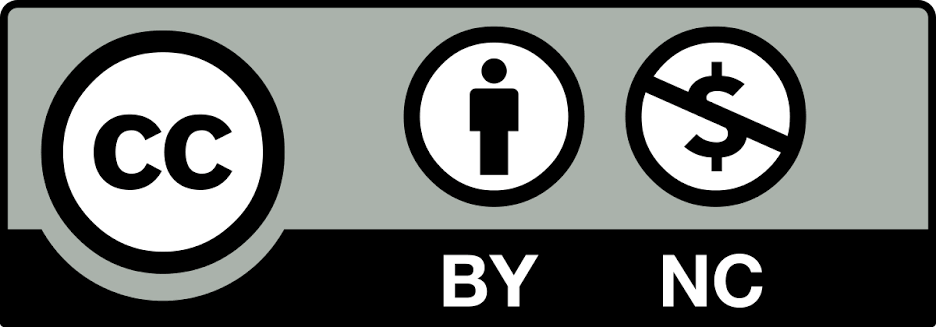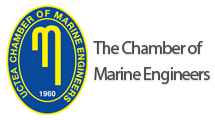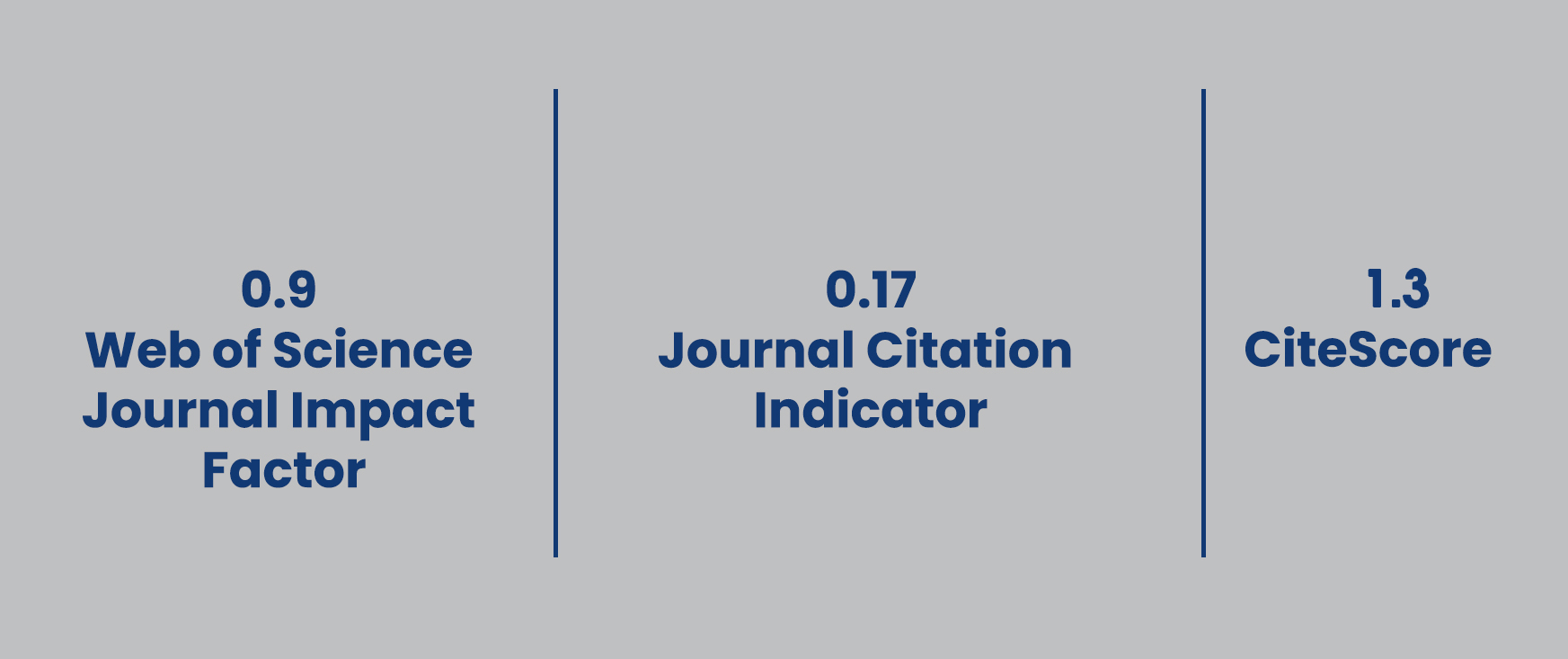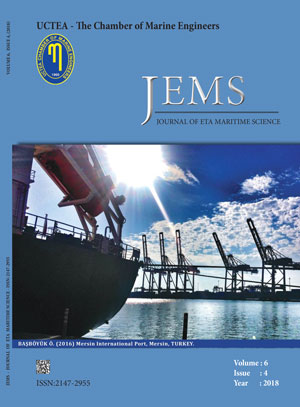

JEMS apply the Creative Commons Attribution NonCommercial 4.0 International Licence to all manuscripts to be published
ABSTRACTING & INDEXING
Volume: 6 Issue: 4 - 2018
| EDITORIAL (ED) | |
| 1. | Editorial Selçuk Nas doi: 10.5505/jems.2018.08769 Pages 289 - 290 Abstract | |
| FULL TEXT | |
| 2. | Journal of ETA Maritime Science (Volume: 6 Issue: 4, 2018) Pages 289 - 391 Abstract | |
| ORIGINAL RESEARCH (AR) | |
| 3. | Design of an Optimal Controller for the Roll Stabilization of Surface Ships with Active Fins Mehmet Selçuk Arslan doi: 10.5505/jems.2018.50570 Pages 291 - 305 In this paper, an optimal controller is designed to control the undesired roll motion of a ship under the effect of sea waves by using active fin stabilizers. The roll dynamics is described by a single-degree-of-freedom nonlinear model. An actuator dynamics is also included to the dynamic system. Sinusoidal and random wave models are used to describe the wave elevation that causes disturbance moments in the ship. A worst-case scenario is the application of the periodic wave to bring the ship resonance, whereas the random waves are used to test the system at the smooth and moderate sea states. In designing the controller, the energy optimal control method, which allows both the closed-loop and real-time control of dynamic systems, is employed, and the control law is obtained analytically. The performance of the controller, under the effect of environmental disturbances, is tested by computer simulations and the results are compared with those from LQR controlled ship. |
| 4. | Application of Alternative Maritime Power (AMP) Supply to Cruise Port Duygu Yıldırım Pekşen, Güler Alkan doi: 10.5505/jems.2018.15870 Pages 307 - 318 The International Maritime Organization, the European Union Council and the US government force ship owners to take necessary measures through international conventions and national legislation to minimize ship-based emissions which damage to the environment and has reached a serious level. Thus, ship operators began to turn towards alternative technologies and fuels that reduce emissions to ensure the maritime trade smoothly. On the other hand, some port operators has started to supply alternative maritime power (AMP) which is electricity from city grid line to the ships at the berth. It is a fact that AMP is one of the best emission reduction alternative technologies for ships during berthing period. This kind of ports providing AMP will be compulsory choice for many ship operators who still use fossil fuel-powered engines in their ships and cannot meet the emission limit requirements at ports, also these ports will contribute to the environmental protection. In this study, AMP application will be examined for the Ege Ports in Kuşadası. Purpose of the study is to calculate the amount of emissions and external costs and to compare with marine gas oil (MGO) when the AMP system is applied to a port. According to comparison of AMP technology with MGO (0.1%S); total air pollutant is reduced by 94% via decreasing SO2 23%, NOx 97%, PM 88%, CO 99%, VOC 64%. On the other hand, it is estimated that total released greenhouse gases are minimized by 41% via decreasing CO2 41%, N2O 85% and CH4 81%. Finally, total emission reduction was about 43%. The economic and environmental benefits to the port hinterland and its country has been estimated by finding extarnal cost. Total externality cost of MGO for human health, ecosystem quality and climate change was found as about Euro 3 million while Euro 0,4 million occured from AMP. |
| 5. | Analysis of Empty Container Accumulation Problem of Container Ports Ünal Özdemir doi: 10.5505/jems.2018.53325 Pages 319 - 332 In this study, the empty container problem is evaluated by quantification of factors related to empty container accumulation as well as alternative ways that can be followed for solutions. The study is mainly constructed as two parts; the first part is on identifying involving factors by using DEMATEL and the second part deals with alternative solutions by applying TOPSIS method. The main causes affecting empty containers were found as trading imbalance, irregular distribution, delivery time, unbalanced freight charges and inadequate port management. Finally, based on applied Multi Criteria Decision Making approach, this study suggest that empty container problem can be solved by sharing infrastructures and equipment among logistic companies, allocating storage areas for empty containers outside the ports and following robust fast custom regulations. |
| 6. | Situational Awareness Analysis of Port Pilotage Services Serkan Kahraman, Yusuf Zorba doi: 10.5505/jems.2018.48569 Pages 333 - 347 Situational Awareness (SA) is generally described as the perception of the elements in the environment within a volume of time and space, the comprehension of their meaning and the projection of their status in the near future. SA has emerged in the military aviation for improving safety and prevention of accidents. In the last decade, it was also used in user-focused areas like civil aviation sector, air and sea traffic operations, nuclear plant facilities, offshore oil platforms etc. In this study, maritime pilots and shipmasters situational awareness levels have been analyzed with the SAGAT method using bridge simulator system and the results have been obtained. The importance of the study is to examine the concept of situational awareness for port pilotage services, which is extremely important for the maritime safety. Some of the key findings are positive effects of experience on situational awareness and those who pay attention to factors such as speed and distance in maneuver possess highest situational awareness. In addition, some improvements are proposed in accordance with the conclusions of this study, to increase the quality of the techno nautical services used by pilots and masters. |
| 7. | The Relationships Between Seafarers' Job Satisfaction, Task and Contextual Performance Murat Yorulmaz doi: 10.5505/jems.2018.20981 Pages 349 - 363 The main purpose of this study is to reveal the effect of seafarers' job satisfaction on the task and contextual performance which are dimension of job performance. It is also another purpose of the study to determine whether there are significant differences between the level of task and contextual performance of seafarers. For the purposes of the study, the data obtained by questionnaire from 416 seafarers working on the tankers were analysed with the help of SPSS 21 and AMOS 21 statistical package programs. It has been determined that both task and contextual performances of job satisfaction levels of seafarers affect the positive direction significantly in the path analysis made by structural equation modelling. In addition, there were statistically significant differences in the task and contextual performances of seafarers with linear relationships. At the end of the study, it was learned that seafarers job satisfaction levels positively affected the change in their task and contextual performance, and seafarers' perception of task performance was higher than perceptual of contextual performance. |
| 8. | A Qualitative Examination of Relational and Contractual Governance Mechanisms in Aliaga Port Cluster Bayram Bilge Sağlam, Çimen Karataş Çetin doi: 10.5505/jems.2018.16362 Pages 365 - 378 The rising importance of port-port user relations is a result of widening roles that ports play within the global supply chains and the increasing impact of these relations on the overall performance of the supply chains. In the governance of these relations, both contractual governance and relational governance play the role and the balance between these two governance mechanisms shapes the characteristics and the quality of the relationship. Focusing on the container terminal-liner shipping agency relations in Aliaga as multiple cases, this study aims to investigate how governance mechanisms are handled in the port industry and how the interplay between these two mechanisms occurs. In accordance with this purpose, interviews are conducted with both representatives of the container terminals and representatives of liner shipping agencies in order to reveal the governance dynamics of said relations. The results reveal that relational governance plays an important role in constituting trust and commitment in between parties. On the other hand, the tendency to rely on contractual governance is found out to be mainly related to the organizational culture of the parties, but relatively limited because of the intense competition in the region. |
| 9. | Effect of the Roll Center Position on the Roll Damping of a Ship Section Burak Yıldız doi: 10.5505/jems.2018.77486 Pages 379 - 391 The accurate calculation of the viscous roll damping is important for the estimation of the ship roll motion. Viscous roll damping can be calculated experimentally or numerically using forced roll oscillation or free roll decay tests. Semi-empirical formulae derived from experiment datas can also be used for the prediction of viscous roll damping. In this study, the effect of the roll center position on the roll damping of a ship midsection was investigated experimentally, numerically and by using Ikedas semi-empirical method. The vertical position of the roll center were shifted from near-bottom to main deck level of the ship section. The roll damping coefficients were obtained experimentally and numerically (CFD) by applying forced oscillation tests to the ship midsection with bilge keels. Semi-empirical Ikeda method was also used for the comparision of the results. It was observed that the numerical results are in good agreement with experimental results and the estimation of roll damping with numerical method is better than Ikeda method. |










